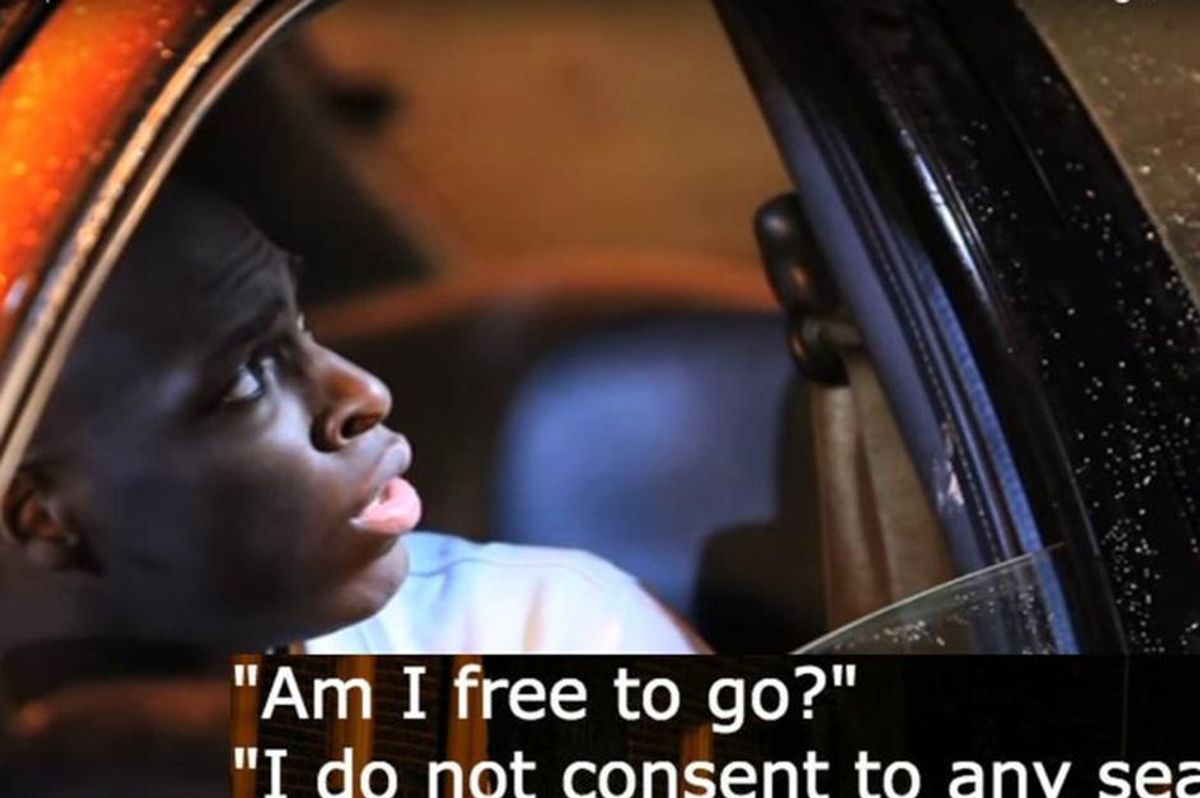The four magic phrases to use when you’re stopped by the cops
Everyone should know their rights.

How to speak to a police officer.
Whether it's a traffic stop that turns into "We smell something in your car" or a "driving while black" situation, you have rights when you're pulled over, and it's for the best if you actually use them.
So how does this work, anyway?
Well, you have rights when you're pulled over. These have been established via case law, and ultimately, some stem from the Constitution itself. In order, here are the magic phrases, along with some graphics to help you remember.
1. "Am I free to go?”
In any situation involving the police, you can ask this question. Some people ask it slightly differently: "Am I being detained?"—which is a version of the same question. Basically, if they've got nothing on you, they have to let you go. If they answer no to that question, you are in fact not free to go. In that case, you are suspected of doing something, and it's their job to try to get you to admit to it or to say a bit too much and incriminate yourself.2. "I do not consent to any searches.”
One of the trickiest things that some law enforcement folks try is to talk you into letting them search your vehicle—or house, for that matter. "So if you haven't done anything, then you're ok with us searching your car … right? I mean, if you're innocent. We'll go easier on you if you let us." Do NOT give up your rights that easily. Are you certain your buddy didn't leave a bag of weed in the glove box? Are you sure your boyfriend took his target pistol out of the trunk after he went to practice shooting the other day? Are you absolutely certain that the body in your trunk was removed and buried in that farm fiel … whoops. Did I say that last one out loud?! The point is, don't give up your rights easily. And believe me, cops are gooooood at trying to play psychological games. Which leads to #3.3. "I want to remain silent.”
You have that right, and if things start getting thick, you need to use it. "We clocked you going 60 in a 50, but when you opened your window to give us your license, we smelled marijuana." The correct answer to something like this is, "I want to remain silent." The temptation is to say, "Yeah, my buddy and I smoked in my car this morning but I wasn't driving, blah blah blah"—but then you're already nailed. Time for them to get the dogs and search. Congratulations, you're on your way to the pokey for the night.
4. "I want a lawyer.”
If you've reach this particular point, then you're in deep doodoo anyway, so go ahead and ask for one, and say nothing until he or she arrives. Remember these four things. It will be hard in the moment, with your adrenaline pumping, your freedom in question, and when you're possibly in physical danger, depending on the cops involved and your skin color.
"Am I free to go?"
"I do not consent to any searches."
"I want to remain silent."
"I want a lawyer."
Perhaps a word involving the first letter of the four statements will help you remember: FoSSiL (Free, Searches, Silent, Lawyer)
Or maybe a mnemonic:
— Fiscal Suns Scramble Lives
— Fresh Sushi Smell Lemons
— Flexible Straws Sell Lobsters
— Free Subjects Steam Lobsters
The clip below is a shortened version of a much longer one that explains your rights, detailing what you can and cannot do in these situations.
This article was written by Brandon Weber and originally appeared on 09.12.17



 Millennial mom struggles to organize her son's room.Image via Canva/fotostorm
Millennial mom struggles to organize her son's room.Image via Canva/fotostorm Boomer grandparents have a video call with grandkids.Image via Canva/Tima Miroshnichenko
Boomer grandparents have a video call with grandkids.Image via Canva/Tima Miroshnichenko
 In a 4-day model, kids often (but not always) receive less instructional time. Photo by
In a 4-day model, kids often (but not always) receive less instructional time. Photo by 
 Worried mother and children during the Great Depression era. Photo by Dorthea Lange via Library of Congress
Worried mother and children during the Great Depression era. Photo by Dorthea Lange via Library of Congress  A mother reflects with her children during the Great Depression. Photo by Dorthea Lange via Library of Congress
A mother reflects with her children during the Great Depression. Photo by Dorthea Lange via Library of Congress  Families on the move suffered enormous hardships during The Great Depression.Photo by Dorthea Lange via Library of Congress
Families on the move suffered enormous hardships during The Great Depression.Photo by Dorthea Lange via Library of Congress
 Play Go GIF
Play Go GIF  Things were different when we were kids.
Things were different when we were kids.  imagination GIF
imagination GIF 
 How can we see a period so differently?Photo credit: Annie Reneau
How can we see a period so differently?Photo credit: Annie Reneau  "Period!" means period. An actual period means nothing.
"Period!" means period. An actual period means nothing. Mic drop.
Mic drop.  A period is just a period. Period.
A period is just a period. Period.